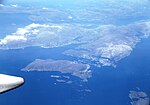In Indo-European studies, the term s-mobile designates the phenomenon where a PIE root appears to begin with an *s- which is sometimes but not always...
11 KB (873 words) - 20:15, 15 July 2024
as well as taw in Welsh. On the absence of the initial s- in Celtic, see Indo-European s-mobile. In Latin, stō, stare retained the meaning "to stand",...
104 KB (3,971 words) - 22:47, 13 August 2024
The Indo-European migrations are hypothesized migrations of Proto-Indo-European language (PIE) speakers, and subsequent migrations of people speaking...
267 KB (29,613 words) - 19:56, 3 August 2024
Proto-Indo-European society is the reconstructed culture of Proto-Indo-Europeans, the ancient speakers of the Proto-Indo-European language, ancestor of...
78 KB (9,373 words) - 03:44, 15 September 2024
used to write reconstructed Proto-Indo-European words (for an explanation of the notation, see Proto-Indo-European phonology). Without proper rendering...
75 KB (7,625 words) - 17:08, 18 September 2024
used to write reconstructed Proto-Indo-European words (for an explanation of the notation, see Proto-Indo-European phonology). Without proper rendering...
57 KB (5,233 words) - 08:41, 31 May 2024
used to write reconstructed Proto-Indo-European words (for an explanation of the notation, see Proto-Indo-European phonology). Without proper rendering...
49 KB (6,272 words) - 13:01, 6 September 2024
used to write reconstructed Proto-Indo-European words (for an explanation of the notation, see Proto-Indo-European phonology). Without proper rendering...
24 KB (2,859 words) - 18:10, 11 August 2024
(The original form must then have been Strums, for the missing s see Indo-European s-mobile.) Another theory holds that Tromsøya was originally called Lille...
36 KB (3,624 words) - 00:15, 17 September 2024
used to write reconstructed Proto-Indo-European words (for an explanation of the notation, see Proto-Indo-European phonology). Without proper rendering...
17 KB (1,982 words) - 13:18, 6 August 2024
research on Indo-European migrations. Early Indians List of ancient Indo-Aryan peoples and tribes Indo-Aryan peoples Indo-Aryan languages Indo-European migrations...
236 KB (27,681 words) - 02:47, 19 September 2024
could compare this to the English word swing (for the missing s see Indo-European s-mobile). The river Glomma passes through the center of the district...
7 KB (513 words) - 11:19, 21 March 2023
(1972:162): Uralic m n l r = Indo-European m n l r. Uralic j w = Indo-European i̯ u̯. Uralic sibilants (presumably s š ś) = Indo-European s. Uralic word-initial...
46 KB (4,497 words) - 14:30, 12 September 2024
(The original form must then have been Strums, for the missing s see Indo-European s-mobile.) Another theory holds that Tromsøya was originally called Lille...
31 KB (2,868 words) - 19:32, 25 July 2024
Germanic substrate hypothesis (redirect from Non-Indo-European roots of Germanic)
creolization between an Indo-European and a non-Indo-European language. A number of root words for modern European words seem to limit the geographical origin...
19 KB (2,088 words) - 01:09, 20 September 2024
(The original form must then have been Strums, for the missing s, see Indo-European s-mobile.) Another theory holds that Tromsøya was originally called Lille...
106 KB (8,506 words) - 13:13, 16 September 2024
reflection of the early presence of Indo-European in Europe. Theories of "Pre-Indo-European" languages in Europe are built on scant evidence. The Basque...
71 KB (6,213 words) - 06:33, 13 September 2024
Proto-Balto-Slavic language (redirect from Mobile paradigm)
is a reconstructed hypothetical proto-language descending from Proto-Indo-European (PIE). From Proto-Balto-Slavic, the later Balto-Slavic languages are...
100 KB (11,146 words) - 08:57, 17 September 2024
could compare this to the English word swing (for the missing s see Indo-European s-mobile). The river Glomma passes through the center of the district...
41 KB (2,731 words) - 17:32, 17 September 2024
Siebs's law (category Proto-Indo-European language)
law is a Proto-Indo-European (PIE) phonological rule named after the German linguist Theodor Siebs. According to this law, if an s-mobile is added to a...
2 KB (260 words) - 02:09, 4 July 2024
could compare this to the English word swing (for the missing s see Indo-European s-mobile). The river Glomma passes through the center of the district...
10 KB (992 words) - 12:05, 22 March 2024
Solaris Mobile (a joint venture between Eutelsat and SES (EchoStar Mobile)) were each awarded a 2×15 MHz portion of the S band by the European Commission...
13 KB (1,503 words) - 01:36, 12 September 2024
after centuries of infiltration of Indo-European Greeks of an unknown origin. c. 1600 BC, most of these Central European cultures were unified in the powerful...
84 KB (8,820 words) - 06:40, 13 September 2024
which means "bank made of stones and gravel". (For the missing s see the Indo-European s-mobile.) View of the beach at Grotle Grotlesanden area Looking south...
5 KB (407 words) - 19:12, 17 May 2023
Yamnaya culture (category Archaeological cultures of Europe)
Pre-Proto-Indo-European among agricultural societies South of the Caucasus, rather "this may support a scenario of linguistic continuity of local non-mobile herders...
68 KB (7,012 words) - 11:47, 21 September 2024
Siemens Communications (redirect from Indo-European Telegraph Company)
telegraph networks in Russia. In 1867, Siemens completed the monumental Indo-European telegraph line stretching over 11,000 km from London to Calcutta. In...
15 KB (1,327 words) - 06:44, 12 November 2023
Pre-Greek substrate (category Pre-Indo-European languages)
The pre-Greek substrate (or substratum) consists of the unknown Pre-Indo-European languages spoken in prehistoric Greece prior to the emergence of the...
43 KB (4,256 words) - 06:00, 12 August 2024
The Horse, the Wheel, and Language (category Proto-Indo-European language)
explores the origins and spread of the Indo-European languages from the Pontic–Caspian steppe throughout Western Europe, Central Asia, and South Asia. He shows...
34 KB (4,484 words) - 01:18, 21 April 2024
Andronovo culture (category Indo-Iranian archaeological cultures)
expanding as far east as the Upper Yenisei River, succeeding the non-Indo-European Okunev culture. In southern Siberia and Kazakhstan, the Andronovo culture...
63 KB (7,073 words) - 12:24, 12 September 2024
Proto-Italic language (category Articles containing Proto-Indo-European-language text)
the comparative method. Proto-Italic descended from the earlier Proto-Indo-European language. Although an equation between archeological and linguistic...
85 KB (4,538 words) - 07:49, 21 September 2024












